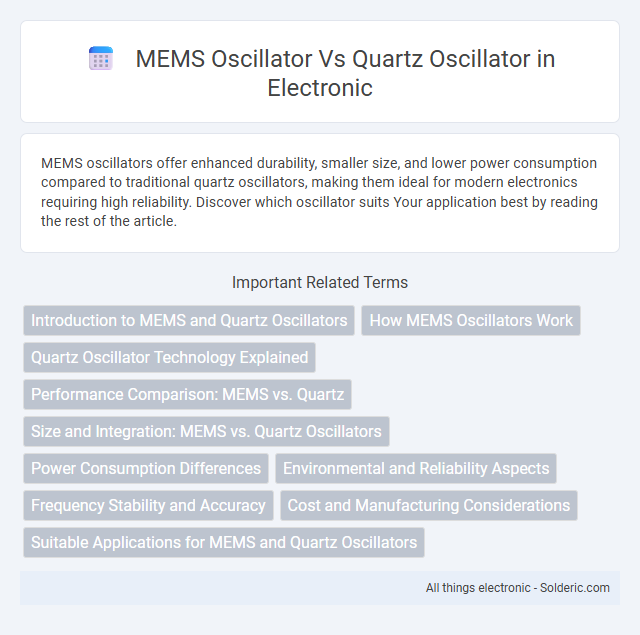MEMS oscillators offer enhanced durability, smaller size, and lower power consumption compared to traditional quartz oscillators, making them ideal for modern electronics requiring high reliability. Discover which oscillator suits Your application best by reading the rest of the article.
Comparison Table
| Feature | MEMS Oscillator | Quartz Oscillator |
|---|---|---|
| Technology | Micro-Electro-Mechanical Systems | Quartz Crystal Resonator |
| Size | Small, compact | Larger, bulky |
| Frequency Stability | Moderate, temperature compensated | High, excellent long-term stability |
| Shock and Vibration Resistance | High, robust under harsh conditions | Lower, sensitive to mechanical stress |
| Power Consumption | Low to moderate | Moderate |
| Frequency Range | Up to hundreds of MHz | Up to tens of MHz |
| Environmental Sensitivity | Better immunity to temperature and humidity | More sensitive to temperature changes |
| Cost | Lower, cost-effective for mass production | Higher, complex manufacturing |
| Applications | Consumer electronics, IoT, automotive | Telecommunications, precision timing |
| Lifespan | Long, solid-state reliability | Very long, proven robustness |
Introduction to MEMS and Quartz Oscillators
MEMS oscillators utilize microelectromechanical systems technology to generate precise frequency signals through mechanical vibrations at a microscopic scale, offering enhanced durability and resistance to shock and vibration compared to traditional quartz oscillators. Quartz oscillators rely on the piezoelectric properties of quartz crystals to produce stable and accurate oscillations, widely used for their low phase noise and temperature stability across various electronic devices. Understanding the fundamental differences in materials and operational mechanisms helps you choose the right oscillator for applications demanding precision timing and environmental resilience.
How MEMS Oscillators Work
MEMS oscillators use microelectromechanical systems to generate precise frequency signals by vibrating a tiny mechanical resonator, typically made of silicon, controlled by integrated CMOS circuitry for signal processing and temperature compensation. Unlike quartz oscillators that rely on quartz crystal resonances, MEMS oscillators offer superior resistance to shock, vibration, and temperature variations, enhancing reliability in harsh environments. Their miniaturized size and low power consumption make MEMS oscillators ideal for advanced applications in telecommunications, consumer electronics, and automotive systems.
Quartz Oscillator Technology Explained
Quartz oscillator technology relies on the piezoelectric properties of quartz crystals to generate precise and stable frequency signals used in clocks, radios, and electronic devices. Unlike MEMS oscillators that use microelectromechanical systems fabricated on silicon wafers, quartz oscillators offer superior frequency stability and low phase noise, making them ideal for applications requiring high accuracy. Your choice between MEMS and quartz oscillators depends on the trade-offs between size, durability, power consumption, and required signal performance.
Performance Comparison: MEMS vs. Quartz
MEMS oscillators offer superior shock and vibration resistance compared to quartz oscillators, ensuring stable frequency performance in harsh environments. Quartz oscillators typically provide lower phase noise and better long-term frequency stability due to their pure crystalline structure. MEMS technology excels in small form factors and lower power consumption, making it ideal for compact, battery-powered applications.
Size and Integration: MEMS vs. Quartz Oscillators
MEMS oscillators offer a significantly smaller footprint compared to traditional quartz oscillators, enabling better integration into compact electronic devices. MEMS technology allows for on-chip integration with other semiconductor components, enhancing system miniaturization and reducing overall production costs. Quartz oscillators, while larger, provide excellent frequency stability but lack the same level of size efficiency and integration flexibility found in MEMS solutions.
Power Consumption Differences
MEMS oscillators typically consume less power compared to quartz oscillators, making them ideal for battery-powered and portable devices. Quartz oscillators require higher drive levels to maintain stable oscillation, leading to increased energy use. Lower power consumption in MEMS oscillators enhances energy efficiency in applications such as IoT sensors and wearable electronics.
Environmental and Reliability Aspects
MEMS oscillators offer superior environmental resilience compared to quartz oscillators, with enhanced tolerance to shock, vibration, and temperature fluctuations, ensuring stable performance in harsh industrial and automotive settings. Quartz oscillators, while highly precise, are more susceptible to mechanical stress and environmental degradation over time, which can affect long-term reliability. You can expect MEMS technology to provide greater durability and consistent frequency stability, making it a preferred choice for applications requiring robust performance under challenging conditions.
Frequency Stability and Accuracy
MEMS oscillators provide excellent frequency stability under temperature variations and mechanical shock, often outperforming quartz oscillators in environments with extreme conditions. Quartz oscillators typically offer superior long-term frequency accuracy and lower phase noise due to their crystalline structure. When precision in frequency stability and accuracy is critical for your application, selecting between MEMS and quartz oscillators depends on the specific environmental factors and tolerance levels required.
Cost and Manufacturing Considerations
MEMS oscillators generally offer lower manufacturing costs due to their compatibility with standard semiconductor fabrication processes, enabling high-volume production and integration with other ICs. Quartz oscillators, while often more precise, involve more complex and costly manufacturing steps such as crystal cutting, tuning, and packaging. Your choice may depend on balancing the higher upfront costs of quartz oscillators against the scalable, cost-efficient production benefits of MEMS technology for your application.
Suitable Applications for MEMS and Quartz Oscillators
MEMS oscillators excel in high-vibration environments, automotive systems, and wearable devices due to their ruggedness and smaller size, making them ideal for IoT and mobile applications. Quartz oscillators are preferred in precision timing applications like telecommunications, aerospace, and laboratory instruments because of their superior frequency stability and low phase noise. Selection between MEMS and quartz oscillators hinges on application requirements for size, environmental durability, and timing accuracy.
MEMS oscillator vs Quartz oscillator Infographic

 solderic.com
solderic.com